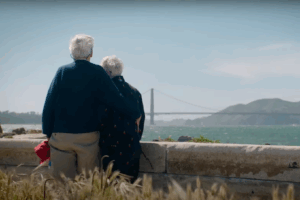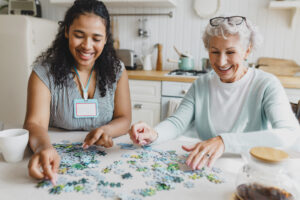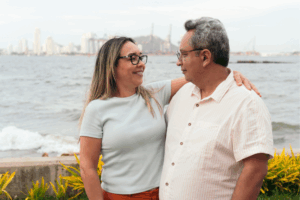My grandma passed away quite a few years ago, but her oldest friend, Cora, still comes to our family gatherings. At our recent celebration of her 83rd birthday, my brother made a comment about how it is so great that she continues to live independently. Cora replied, “I don’t think I’ve ever actually lived independently. Even when I was in my prime at your age, I still leaned on the people and the help around me. I can’t imagine what real independence would be like. Lonely, I think.”
Cora is happy to be still living in her long-time San Francisco home; just as importantly, she is still living in the community she has known and that has supported her health and happiness for years. The best aging in place communities in San Francisco and elsewhere are built on interdependence among residents, businesses, services, and the infrastructure itself. Interdependence implies give and take: residents benefit from the resources in their neighborhood, but they also invest their own resources and talents back into the community. In this way, aging and thriving in place doesn’t just mean that an individual has everything they need; it also means that they belong.
What Do San Francisco Communities Need to Best Support Aging in Place?
When aging in place works well, not only is it the option that individuals typically prefer, but it is also less expensive than many options for assisted living. As the senior demographic continues to grow, we have every reason to invest in the foundation for aging in place for current and future generations in San Francisco. For communities to work well for older adults, the following comprehensive services must be available and accessible:
- Solutions for Making Homes Safe and Accessible. In many cases, small changes can make a big difference in older adults’ homes. Installing safety railings, eliminating tripping hazards, introducing ergonomic seating, and installing adequate lighting are just a handful of the solutions that can make a home safer and more comfortable. You can get a comprehensive assessment from a professional care manager, and that assessment will include recommendations for relevant home improvements.
- Neighborhood Awareness and Assistance. When people in a neighborhood are familiar with each other, they have friendly options for assistance, socialization, and sense of belonging. And people in the community can have their eyes out for each other and for anything unusual happening around them. In some cases friends may call each other each morning just to make sure the other is well. There are even opportunities to join organized neighborhood villages in San Francisco for greater cooperation. Another consideration is that neighborhoods should have adequate street lighting for residents to be and feel safe.
- Affordable Quality Home and Day Care Options. Diverse options for caregiving and general assistance make aging in place possible for seniors and their families. Each person’s situation and needs are different, so it’s important to be able to personalize the approach to care. Care programs need to be compassionate and affordable, whether one needs full-time help in the home, occasional at-home help, or an on-site day care program.
- Access to Broad Health and Wellness Services. Complete wellness boils down to much more than just medical health, as we see from this list of significant resources. But It’s important for aging adults to have access to local healthcare services, including medical and dental care, mental health and rehabilitation, support groups, pain management, physical therapy, and occupational therapy.
- Access to Nutritious Groceries and Meals. As nutrition underlies much of our health and well-being, it is critical for seniors to maintain a wholesome diet of nutrient-dense foods. Grocery delivery services can be a major help in San Francisco, where it can be challenging to transport groceries when strength or mobility is limited. Older adults may find that meal prep or meal delivery services are helpful too.
- Adequate Transportation Options. In order to maintain a productive interdependent lifestyle in San Francisco, older adults must be able to get around in the city to take advantage of various opportunities. Maneuvering in urban environments is much different than in suburban and rural areas where travel by car is more common and accessible—and especially when hills make walking more difficult. Ride services such as Uber and Lyft are common throughout San Francisco, as is SilverRide, a private taxi service geared to seniors.
- Opportunities to Socialize and Stay Connected to a Sense of Purpose. Just as friendly connections provide opportunities for assistance and safety awareness, they also open up opportunities for socialization and counteract isolation. This community network can connect older adults to opportunities to volunteer, to work even after retirement, and to stay active in their interests.
There are even programs that wrap these needs into one convenient source, such as Programs of All-Inclusive Care for the Elderly or PACE. Typically funded by Medicare and Medicaid, these options are affordable for families looking for solutions to support aging loved ones in their homes. PACE is a PACE opportunity in the Richmond District of San Francisco that offers medical care, various wellness therapies, social services and activities, transportation if needed, meals, and opportunities for physical exercise. As a regular activity each week, this Social Day Program can also serve as an opportunity for respite care for family caregivers in need of time for themselves and their own needs.
The Best Aging in Place Communities Are Constantly Evolving
The community itself benefits from residents remaining and helping to evolve it over time. Residents have the most important perspective on how a neighborhood can grow and improve. But they need to have a way to express their voices. This is where initiatives such as One Richmond come into play, helping us to take stock of what works and to take action in areas that don’t. Actively engaging older adults in assessing and restructuring neighborhood services, programs, and codes for public and private facilities brings these decisions down to the ground where they really matter. Aging in place becomes a progressive possibility through empowered community living.
For more ideas about graceful aging and thriving at home, check out our blog. Institute on Aging offers powerful programs, services, and resources for older adults, family members, and caregivers. Reach out today to find out how we can help to support you and your interdependent life.







